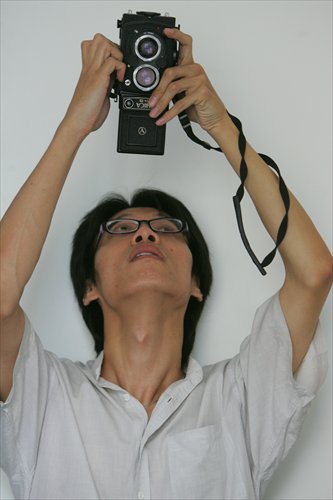Non-visual photography helping more people express themselves

Visually impaired photographer, Sun Zhiyuan Photo: Courtesy of Sun Zhiyuan

Sun Zhiyuan uses photography to express his feelings of encountering obstacles in the outside world as a person with impaired vision. Photo: Courtesy of Sun Zhiyuan
"I can see sensations in my mind," says Sun Zhiyuan, a visually impaired photographer.
In one of his favorite photos, titled "Obstacle," a rope spans across the picture with Beijing's Chang'an Avenue in the background. Sun took the photo after he walked into a rope and fell on his way to a concert.
It's not the first time this happened to Sun. He can only see very blurry images due to amotio retinae, a condition in which the retina peels away from its underlying layer of support tissue. Sun has fallen into wells, walked into clothing lines and bollards. On the avenue, the rope was not the only obstacle, and Sun realized that all those hindrances not only impeded him, but also others.
"Touch, sound, smell, inner feelings and other factors, rather than lighting or the composition of a picture, are the triggers for pressing the button for a visually impaired photographer," said Sun.
He has held a training workshop for more than 40 visually impaired people in Tianjin which ends today. Named "Sights Unseen," the photography workshop initiated by Sun in 2009, has helped more than 200 visually impaired people.
Sun, the founder of a Tianjin-based non-governmental organization (NGO) called Yixin, has managed to do several exhibitions of his works in Beijing, Tianjin and Shenyang in Liaoning Province. Six years ago, Sun was one of the first people in China to learn from visually impaired photographers from the UK. He's determined to explore more ways to practice the art locally. Up until now, Sun has been exploring how photography can help partially sighted people experience the world better, and how it can help blind people be more confident at expressing themselves.
With assistance from volunteers who help describe the scene and later the photo, the visually impaired photographers decide how and when to take the photos.
"What's in the photo and the composition are not important. The people and stories that are embodied in the picture are," said Sun.
Zhao Naihui is one of Sun's students who has made the biggest improvement and shown the greatest potential. A masseuse who's completely blind, Zhao took quite a good headshot photo of her 3-year-old grandson, receiving praise from her husband and her grandson.
"I focus on my feelings. We [with impaired vision] can do what people with perfect vision can do, and I feel great," said Zhao. A willing and determined person, Zhao has learned to use a computer and a touch-screen phone, and she is confident that photography will be her next accomplishment.
"After the workshop, I learned to use my feelings to take photos, which turned out well," said Wang Jing, a 54-year-old retired worker from the cosmetics industry. Contracting cephalomeningitis when she was 6, impaired her vision and since then Wang can only see blurry shadows and light.
Wang loves singing and often performs at community events. She wants to preserve her memories by taking good photos, especially selfies in her beautiful performance gowns.
Wang has learned all the basic techniques, but what's more important to her is how it feels when she presses the button.
"The art of photography means a lot for visually impaired people. It gives them confidence, helps them to communicate and preserve their memories and many other aspects," said Wang. "For example, I won't feel inferior and will be able to better communicate if we travel together because I can also take your photos."
Sun says everybody can participate in non-visual photography and can benefit from it. "Even people with perfect vision can temporarily shut down their vision, and arouse all the other sensations," he said. "When you utilize those other sensations, they inspire very powerful and unusual feelings."
Sun was given a photo taken by a friend of a hand rail in summer time. "It was very hot when he touched it, and he wanted to express what it felt like. I think this kind of non-visual thinking is very interesting and astounding," he said.
"Non-visual photography is actually a style of thinking, a delivery of inner feelings," he concluded.
Newspaper headline: Seeing through the mind’s eye